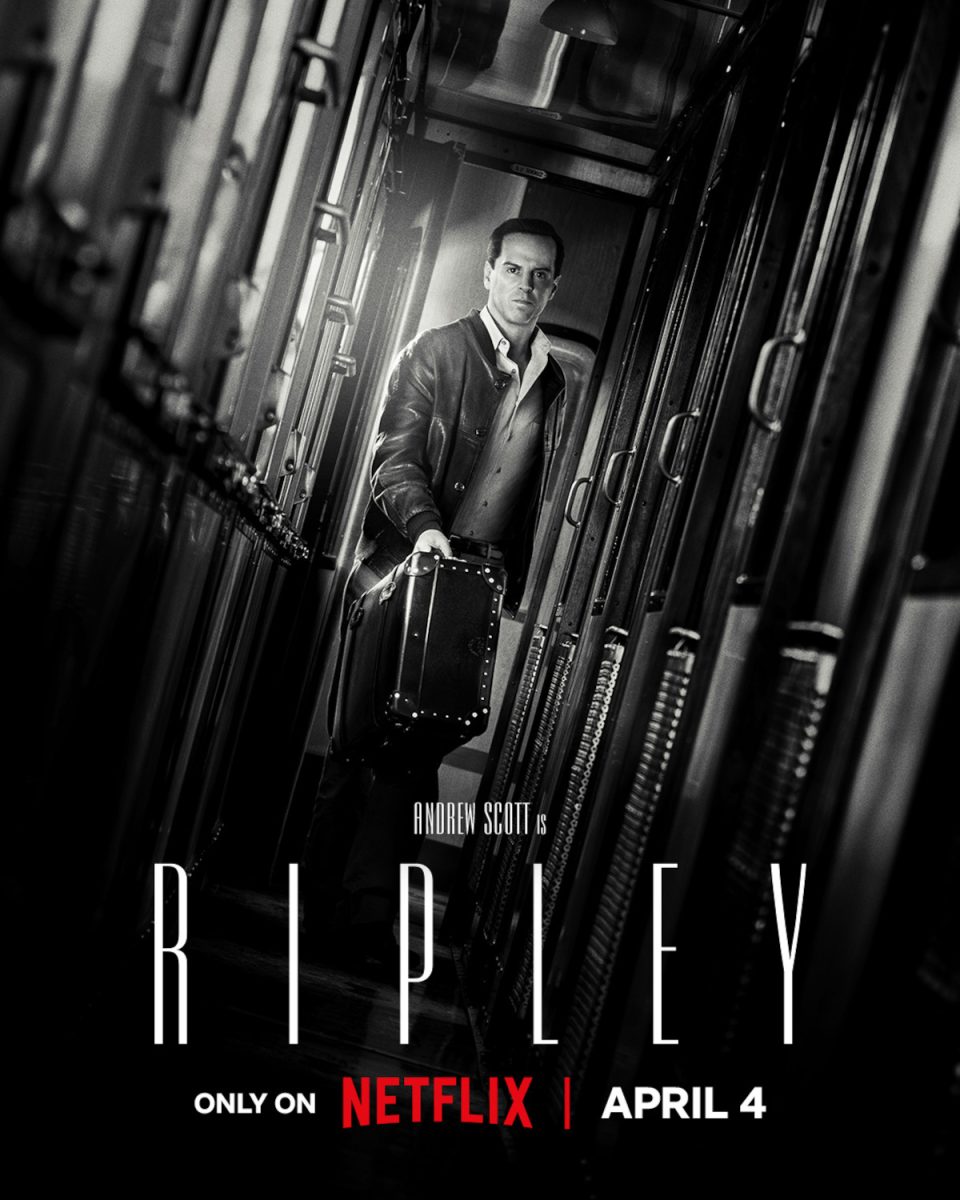Patricia Highsmith’s 1955 psychological thriller novel, “The Talented Mr. Ripley”, has once again been adapted for modern audiences. This time, however, the titular Mr. Ripley has found a home in the new Netflix limited series, “Ripley,” directed by Steven Zaillian, which succeeds in capturing the discomforting, suspenseful, and ominous tone of the novel while perhaps alienating viewers with the show’s dissonant tone and directorial choices.
Set in 1960, the story follows Tom Ripley, a fraudster from New York City, who is tasked by shipping magnate Herbert Greenleaf to convince his son, Dickie Greenleaf, to return from Italy in order to take over the family business. Tom, an apparent college friend of Dickie’s, accepts the task and soon finds himself seduced by the luxuriousness and joy of Dickie’s picaresque life in Italy while also harboring dark feelings towards his supposed friend. When Tom’s stay in Italy is threatened, a series of malignant machinations and manipulations is initiated that sees Tom addled with paranoia as he tries to avoid detection while preserving his new life in Italy by any means necessary.
Consisting of 8 suspenseful episodes, “Ripley” achieves new heights that previous adaptations of Highsmith’s novel were unable to reach. This adaptation achievement is due to the exceptional casting, considerate directing, thematic-oriented cinematography, and intricate sound design.
In the titular role of Tom Ripley is everyone’s favorite hot priest from “Fleabag”, Andrew Scott, who delivers an exceptional performance of the chameleon that is Tom Ripley. Some may critique Scott’s performance as rather charmless when compared to previous iterations of the character portrayed by Matt Damon and Alain Delon. However, I think it is specifically the “blank slate” aspect of Ripley’s character that makes him just so intriguing.
This is a character who, thanks to Scott’s performance, is able to emit an aura of awkwardness, soft-spoken charm, and naive adoration while still being able to create an underlying sense of menace that makes even his nicest actions feel all the more bitter and ominous. Just like in the novel, Ripley is not a character who can be tied down but rather one who must be watched like a hawk because all of his actions and words are coordinated to achieve an ulterior motive that can sneak up on the unexpecting.
One person cannot carry a limited series, however, so credit is due for the commendable supporting cast such Johnny Flynn who plays the charming shipping heir Dickie Greenleaf, Dakota Fanning who plays Dickie’s skeptical wealthy girlfriend Marge Sherwood, and Eliot Sumner who plays Dickie’s delightfully hateable and condescending friend, Freddie Miles. This is an exceptional ensemble cast that brings Highsmith’s characters to life in intriguing and delightful ways.
There has been a critique floating around that the majority of the cast are too old for their respective roles such as Andrew Scott, nearly 50 years old, playing Tom Ripley who is supposed to be in his early to mid 20s. I find this critique to be almost completely negated thanks to the wonderful directorial choice to shoot the entire series in black and white.
Shooting the series in black and white makes the age difference unnoticeable and allows for an effectively noir styled cinematography that uses chiaroscuro lighting to highlight the characters in a way that serves to amplify the suspense of each and every scene even during the daytime portions of the series. Frequent symmetrical framing reinforces the idea that this is Tom Ripley’s story and helps to illustrate the narcissistic way that Ripley not only positions himself in the world but, when symmetry broken, Ripley can escape into the crevices and nooks of the screen. Visual motifs such as the frequent presence of mirrors resulting in a dual image of Ripley works splendidly to highlight both the theme of identity present throughout the series while also commenting on the dual lives that Ripley seeks to maintain as his plot continues to develop and adapt.
The sound design of “Ripley” is also worthy of praise for the way in which it reveals the inner psyche of the complex titular character. Every single noise is drawn into the soundscape of the series so as to put the viewer on edge and create the overwhelming sense of paranoia that Tom Ripley is dealing with as his machinations risk his own exposure. Footsteps, the opening of doors, the whirring of elevators, hushed conversations, scribbling, and much more are all accounted for in the sound design. This emphasis on even the tiniest noise raises the stakes and makes the viewer question the significance of every single action similar to how Ripley goes out of his way to account for every possibility and leaves nothing to chance as the stakes are just that extreme.
All of the aforementioned elements of “Ripley” are exceptional and feel like a respectful and considerate approach to Patricia Highsmith’s intricately layered source material. In translating these layers to the screen, a round of applause for director Steven Zaillian is well earned. Zaillian crafts a web of lies and manipulation that pulls the viewer further in while still maintaining sympathy for the cold blooded fraudster that is Tom Ripley without straying far from Tom’s nuanced characterization in the novel. It must be mentioned, however, that this series will displease a handful of people due to the directorial choice of highlighting the dissonance between Ripley and his surroundings, the narrative’s intentional and glacial pacing, as well comparisons drawn between this adaptation and previous adaptations. All I can say is that, as far as adaptations of the “Talented Mr. Ripley” go, Zaillian’s “Ripley” stands as a unique and complex series that makes bold directorial choices while remaining true to Highsmith’s novel on top of elevating the source material to astonishing, seductive, and insidious new heights.
Rating: 5/5













